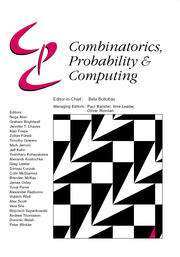Article contents
Many Hamiltonian subsets in large graphs with given density
Published online by Cambridge University Press: 02 October 2023
Abstract
A set of vertices in a graph is a Hamiltonian subset if it induces a subgraph containing a Hamiltonian cycle. Kim, Liu, Sharifzadeh, and Staden proved that for large  $d$, among all graphs with minimum degree
$d$, among all graphs with minimum degree  $d$,
$d$,  $K_{d+1}$ minimises the number of Hamiltonian subsets. We prove a near optimal lower bound that takes also the order and the structure of a graph into account. For many natural graph classes, it provides a much better bound than the extremal one (
$K_{d+1}$ minimises the number of Hamiltonian subsets. We prove a near optimal lower bound that takes also the order and the structure of a graph into account. For many natural graph classes, it provides a much better bound than the extremal one ( $\approx 2^{d+1}$). Among others, our bound implies that an
$\approx 2^{d+1}$). Among others, our bound implies that an  $n$-vertex
$n$-vertex  $C_4$-free graph with minimum degree
$C_4$-free graph with minimum degree  $d$ contains at least
$d$ contains at least  $n2^{d^{2-o(1)}}$ Hamiltonian subsets.
$n2^{d^{2-o(1)}}$ Hamiltonian subsets.
Information
- Type
- Paper
- Information
- Copyright
- © The Author(s), 2023. Published by Cambridge University Press
Footnotes
Supported by the Institute for Basic Science (IBS-R029-C4).
Supported by Internal Funds of KU Leuven (PDM fellowship PDMT1/22/005).
References
- 1
- Cited by


